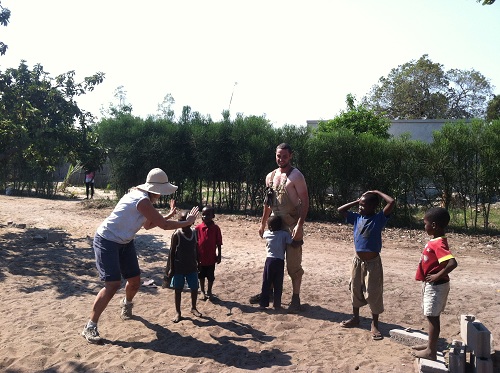Bringin’ the Fun to Mozambique
Parents back home will travel miles and spend hours attending the next sporting event that their children are participating in. Hovering parents...
Saturday, January 23, 2010 - Jeff Smith
Today was our tour of a local slum in an area called Villa Nueva in Guatemala City. In keeping with Latin American tradition, our 8am scheduled tour started around 9ish. We were picked up in a mini-bus (along with our 15 policemen as our security escorts) and we were off. As we followed the windy and narrow road on our way to the slum, we were joined by several community leaders who began giving us a first-hand account of the current conditions of the residents of Villa Nueva.
When we arrived in the municipality of Villa Nueva we were met by others of the community who added to the history of Villa Nueva and spoke of the struggles they have endured just to retain their inhabited plots of land.
As we started walking through the sandy, dusty roads, I was overwhelmed by the intense odor and the steady stream of water running along the left side of the road. I asked if it rained recently (which judging by the amount of dust in the air was a stupid question) to which they said “no." They explained that the water running alongside the road was raw sewage—there is no other sewage system to speak of.
Outside of the homes (which were made out of salvaged materials such as tin, cardboard, and plastic) were rusty barrels of water. Each day a large truck drives through the neighborhood filling up these water barrels for roughly $1.50 per day. To my knowledge this water was used for drinking and cooking (which would need to be boiled because it was not potable), washing clothes and bathing. Sometimes families could not afford fuel to boil the water so they would take their chances and drink the water without boiling it, which we learned from community leaders that 90% of the children had gastrointestinal infections because of the water, causing an infant mortality rate of 50%.
I also noticed near the edge of the road was a large ravine that appeared to be collecting garbage. This was where much of the garbage from the neighborhood ended up. When the pile got too high, they burned it. It was apparent that those families closest to the makeshift landfill got the worst end of having to breathe in the fumes—but I am sure that after awhile, the whole community was breathing in these fumes.
This all leads me to a topic that has been talked a lot about around Habitat these past few years: having access to safe, stable housing is directly linked to many different areas of a community (environment, employment, transportation, education, and in this case health). Probably not surprising, many of these inhabitants of Villa Nueva have a significantly high rate of respiratory problems and gastrointestinal problems. All of the issues I noted above (lack of access to potable water, poor air quality, and lack of a sewage system) could be eliminated or at least greatly reduced if these people had safe, stable housing.
As we met with community leaders at the end of our tour, there was a lot of talk about the fact the closest hospital is 13 kilometers away (I don’t know exactly how many miles that is but the 5K I ran two summers ago tells me it is not close, or maybe that meant I was drastically out of shape…sorry, I digress). There was even a friendly debate about the new hospital that a candidate for local government has promised to build adjacent to Villa Nueva. Some were awfully skeptical that this campaign promise would actually be built to serve this community desperately in need of help. But what gave me hope was the faith that many residents had in the political process. For a community that has been promised much by the government and received very little, I was humbled by the hope these people outwardly expressed. And for me, that hope is contagious and one I won’t soon forget.
View our pictures on Flickr at http://bit.ly/8qRili
Your gift unlocks bright futures! Donate now to create, preserve, and promote affordable homeownership in the Twin Cities.

Parents back home will travel miles and spend hours attending the next sporting event that their children are participating in. Hovering parents...
Wednesday, January 20, 2010 - Jeff Smith
An intergenerational group of volunteers from the Twin Cities will build Habitat homes in La Cruz Costa Rica between March 10-19. Twin Cities Habitat...